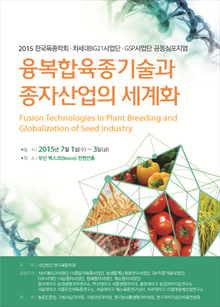간행물
한국육종학회 심포지엄

- 발행기관 한국육종학회
- 자료유형 심포지움
- 간기 연간
- 수록기간 2012 ~ 2015
- 주제분류 농수해양 > 농학 농수해양 분류의 다른 간행물
- 십진분류KDC 523DDC 634
권호리스트/논문검색
2013 한국육종학회-차세대BG21사업단 공동심포지엄 (2013년 7월) 243건
241.
2013.07
서비스 종료(열람 제한)
Environmental stresses including drought, extreme temperatures, and high salinity are major factors that severely limit crop productivity worldwide. To overcome yield loss due to these environmental stresses, a large number of researches have been conducted to understand how plants respond to and adapt these environmental stresses. Posttranscriptional regulation as well as transcriptional regulation of gene expression is recognized as a key regulatory process in plant stress responses, and these cellular processes are regulated by diverse RNA-binding proteins (RBPs). Over the last years, we have extensively investigated the functional roles of RBPs that harbor an RNA-recognition motif at the N-terminal half and a glycine-rich region at the C-terminal half (glycine-rich RNA-binding proteins, GRPs), zinc finger-containing GRP, and cold shock domain proteins (CSDPs) in Arabidopsis thaliana, rice (Oryza sativa), wheat (Triticum aestivum), and rapeseed (Brasicca napus) under stress conditions. Our comparative analysis demonstrated that certain family members display RNA chaperone function during stress adaptation process in monocotyledonous plants as well as in dicotyledonous plants. These findings point to the importance of the regulation of mRNA metabolism in plant response to environmental stresses and shed new light on the practical application of these RBPs to develop stress-tolerant transgenic crops.
242.
2013.07
서비스 종료(열람 제한)
In some plant species, prolonged exposure to low temperature during the winter season is necessary to acquire the competence to flower in the following spring. This process, known as vernalization, is an epigenetic change in which a mitotically stable change of the developmental potential of the meristem (competence to flower) is maintained even in the absence of the inducing signal (prolonged cold exposure). In Arabidopsis, vernalization results in stable epigenetic repression of a potent floral repressor, FLOWERING LOCUS C (FLC). Increased enrichment of Polycomb Repressive Complex 2 (PRC2) and trimethylated Histone H3 Lys 27 (H3K27me3) at FLC chromatin is necessary for the stable maintenance of FLC repression by vernalization. A long intronic noncoding RNA (termed as COLDAIR) is required for the vernalization-mediated epigenetic repression of FLC. COLDAIR physically associates with a component of PRC2 and targets PRC2 to FLC. COLDAIR is required for establishing stable repressive chromatin at FLC through its interaction with PRC2. In addition, floral integrator genes are targets of PRC2 complex, resulting in delayed flowering time through repression mechanism of PRC2 complex. Recently another long non-coding RNA was isolated from floral integrator gene and characterized the function of this long non coding RNA.
243.
2013.07
서비스 종료(열람 제한)
In the era of systems biology, plant biologists approach any given phenomena, that they have great interests, from different perspectives. Among them, both epigenomic and epigenetic studies give us new insights into plant immune response as well as development. In plants, recognition of invading pathogenic microorganisms by pattern recognition receptor and race-specific resistance protein activates diverse cellular responses to defend plants against pathogen infection. One of well-known immune responses is the transcriptional reprogramming occurring when pathogen infects plant. Chromatin remodeling caused by change of histone marks and replacement of histone variants affects gene expression that is important for immunity. We are focused on unveiling epigenomic and epigenetic regulatory mechanisms of plant immunity. To address these questions, we have collected knockout mutant plants whose genes might be related to histone modifications, and identified several enhanced-immune (eni) mutants and immune-defective (imd) mutants. Here, we will introduce one of mutants showing enhanced disease resistance (EDR) in response to the infection of Pseudomonas. Thus we named it eni2. Both the growth of virulent bacteria, not avirulent derivatives of Pseudomonas syringae, and symptom development were effectively inhibited in the eni2 mutants, compared with those seen in wild type. Unlike to well-known EDR-type mutants, the levels of salicylic acid in the eni2 mutant plants were not different from those in wild type. Thus we suggests a few plausible scenarios about role of ENI2 in plant immune response. To examine these possibilities, we are monitoring transcriptional reprogramming occurring in eni2 mutants through RNA-seq analysis. On the other hand, we have recently initiated the study of tomato small RNAome in order to discover immune-related small RNAs from leaves infected with Pseudomonas syringae via next-generation sequencing technology. Here we present the recent progress in this study.

